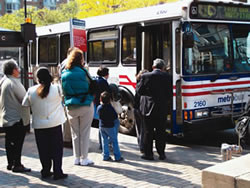U.S. Department of Transportation
Federal Highway Administration
1200 New Jersey Avenue, SE
Washington, DC 20590
202-366-4000
| < Previous | Table of Content | Next > |
 The primary goal of transit providers is to carry passengers between residences, employment and other destinations in a safe, convenient, efficient and reliable manner. The physical safety of passengers is vital to the success of any transit system—not only to retain existing riders but also to encourage new riders. This is true both while passengers are on board a transit vehicle as well as when they are accessing the system. To access a transit stop or station, all passengers travel at least a short distance by foot, wheelchair, bicycle, or other assistive device.
The primary goal of transit providers is to carry passengers between residences, employment and other destinations in a safe, convenient, efficient and reliable manner. The physical safety of passengers is vital to the success of any transit system—not only to retain existing riders but also to encourage new riders. This is true both while passengers are on board a transit vehicle as well as when they are accessing the system. To access a transit stop or station, all passengers travel at least a short distance by foot, wheelchair, bicycle, or other assistive device.
 In recent years, courts in several states have ruled that transit agencies are obligated to address the safety of passengers accessing the system, leaving the system, and transferring between vehicles. Transit agencies should consider the effects of the surrounding environment on pedestrians when planning service and stops, and they should implement changes that will increase the safety of passengers accessing the transit system.
In recent years, courts in several states have ruled that transit agencies are obligated to address the safety of passengers accessing the system, leaving the system, and transferring between vehicles. Transit agencies should consider the effects of the surrounding environment on pedestrians when planning service and stops, and they should implement changes that will increase the safety of passengers accessing the transit system.
Transit agencies play a critical role in making conditions safe for pedestrians traveling to and from transit stops. Transit agencies can help ensure that their vehicles are operated safely near pedestrians and that their stops and stations provide safe pedestrian access. However, agencies are often limited in their ability to take unilateral actions to improve pedestrian safety. Transit agencies frequently lack the authority to address transit access on property not owned by the agency. In order to improve safety for their customers, transit agencies should build partnerships with other organizations and local government agencies, especially those that own and maintain public rights-of-way.
Adequate sidewalks, pathways, and roadway crossings in the area around transit access points and amenities such as benches, shelters, and lighting at stops and stations are important for pedestrian comfort and safety. The most successful transit systems have safe and convenient pedestrian access and provide comfortable waiting areas, all of which encourage greater transit use.
| < Previous | Table of Content | Next > |
